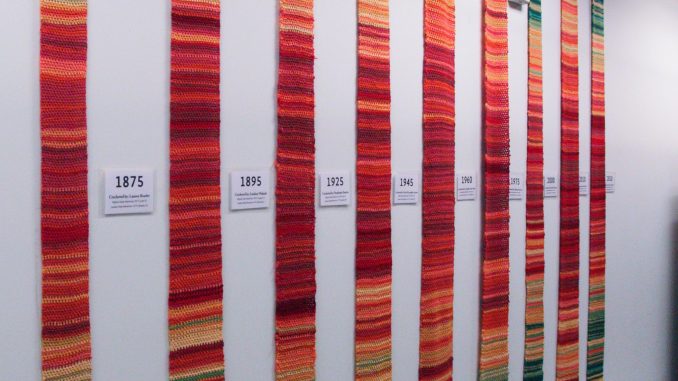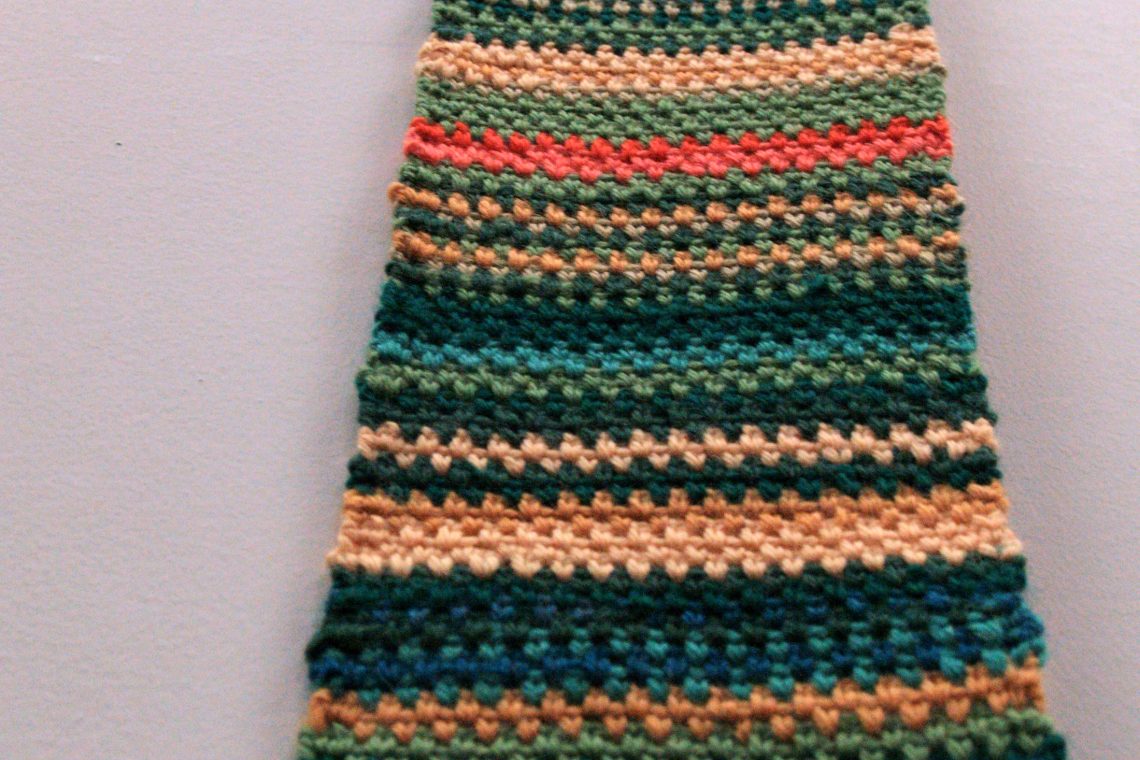
Rows of vibrant colors adorn the wall of the Ginsburg Health Sciences Library in carefully knitted tapestries that form an artistic rendering of the increasing temperatures in cities all over the world.
These “Tempestries,” or tapestries that record the daily high temperatures of a city for one year, are exhibited at the Lewis Katz School of Medicine until March 12. The nine tapestries show nine years of Philadelphia temperatures between 1875 and 2018. They’re a part of the Tempestry Project, an international organization of knitting tapestries that show global warming.
From 1880 to 2019, the Earth’s temperature rose by more than 2 degrees Fahrenheit, according to NASA. In January, the temperature in the United States was the highest on record at 35.5 degrees, the National Oceanic and Atmospheric Administration reported.
The Tempestries are hand-knitted by volunteers who buy a kit from the Tempestry Project. In the kit, they receive spreadsheets of temperature data for their chosen year and corresponding colored yarn they’ll need. Each temperature range has a color associated with it, so the finished tapestry will have 365 rows for each daily temperature, taking 20-30 hours to make, according to the project’s website.
The exhibit was a part of “Love Data Week,” an annual event recognizing data that ran from Feb. 10-14, said Will Dean, research and data services librarian at the Ginsburg Health Sciences Library.
The library has participated in Love Data Week for several years and hosted workshops and events centered around data, research and education,Dean said.
“In the past, we’ve only had technology and workshops, so it’s our first time having more of an artistic installation that’s still based on scientific data,” he added. “It’s both eye-catching and a reminder that there are a lot of things you can do with data.”

Part of the exhibit includes descriptions of the climate trends that show varying temperatures through different-colored yarn. The descriptions show the effects hotter temperatures can have, like increased disease, loss of agriculture and threats to infrastructure, like rising sea levels and extreme weather.
“We hope to help people connect with the issue in new ways,” said Justin Connelly, co-founder of The Tempestry Project. “With the Tempestries, you find people connect a little bit deeper, spend more time with it, think about it a little bit more.”
The project was created in 2017 when Connelly, alongside Emily McNeil and Marissa Connelly, felt environmental data was threatened by President Donald Trump’s administration and would be better preserved in a non-digital space. Since then, tapestries have been made in 48 out of 50 states and more than 30 countries, Justin Connelly said.
“Just in the making of the pieces, there’s thousands of hours of people thinking about climate, which they might not otherwise end up doing,” he said. “I think of it as every knitter who makes one is spending 20 to 30 hours thinking about climate.”
The exhibit is on loan from the Schuylkill Center for Environmental Education, an institution in Roxborough focused on environmental education and art, land stewardship and wildlife rehabilitation. The center is home to 30 Tempestries, making it the largest Tempestry collection in the world, the Philadelphia Inquirer reported.
In the library exhibit room, a whiteboard stationed by the Tempestries asks visitors to write what they thought of the installation, where visitors wrote responses like “an extremely effective and timely piece of art.”
Arvind Bussetty, a first-year medical student, went to the exhibit room to see the project, but then stayed to do homework. The project looked well thought out, and passionately made, he said.
“It’s a really nice way to show something that concerns us all,” Bussetty said. “It’s very appealing, and does a good job of showing how dire the effects of climate change are.”



I actually made one of these – I think it was 1930 or 1935. Really striking to see the progression in time.